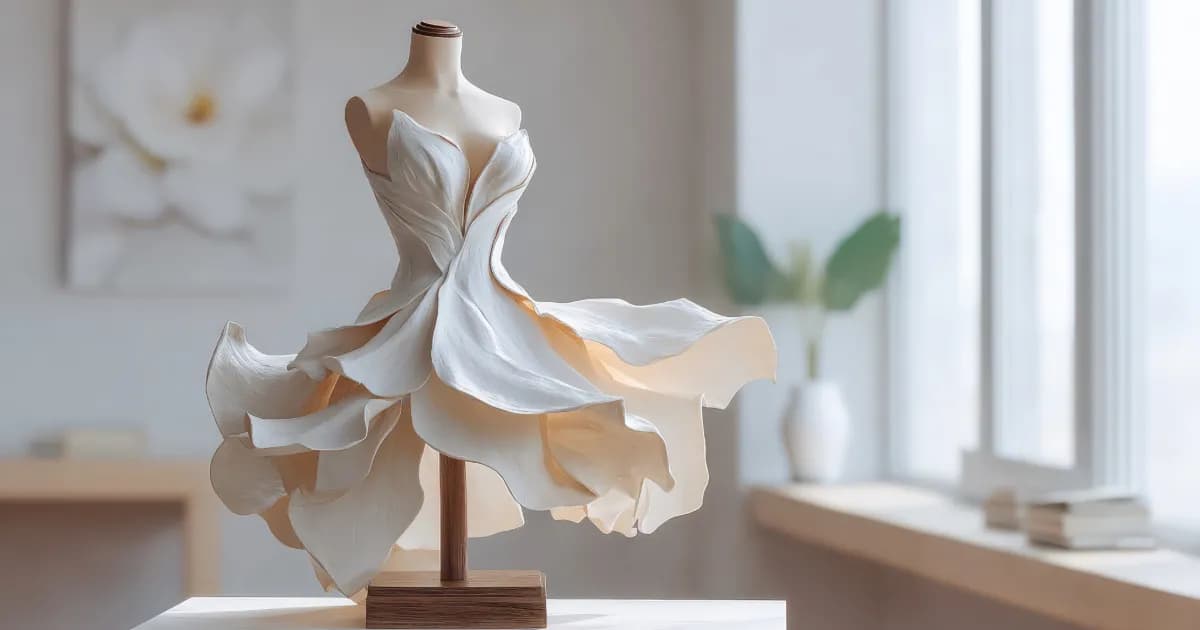Loading...
27 June 2025

Fashion is an ever-evolving canvas, constantly redefining what it means to adorn the human form. For years, we've seen cycles of minimalism and maximalism, comfort and constraint. But as we step deeper into 2025, a powerful and transformative trend is taking center stage: sculptural fashion. This isn't just about clothes; it's about wearable art, where garments transcend mere utility to become three-dimensional expressions of form, volume, and architectural ingenuity. The runways of New York, London, Milan, and Paris have been abuzz with this shift, signaling a profound return to artistry in design. Designers are no longer simply dressing the body; they are sculpting it, creating silhouettes that are bold, dramatic, and imbued with a sense of deliberate construction. At the heart of sculptural fashion lies a deep reverence for architecture. Just as an architect envisions spaces, fashion designers are now envisioning shapes. Think of the precise lines of a modern building, the graceful curves of a historical dome, or the unexpected angles of a contemporary structure. These elements are directly influencing the cut, drape, and overall silhouette of garments in 2025. We're seeing strong, defined shoulders that command attention, voluminous sleeves that create a sense of dramatic flair, and skirts that flow or stand in rigid, deliberate forms. Hips are exaggerated, waists are cinched into new proportions, and hemlines become artistic statements rather than mere boundaries. It's a testament to the idea that clothing can, and should, be a movable monument to design. What exactly does "sculptural fashion" look like in practice? It’s a multifaceted trend characterized by several distinct elements: Exaggerated Volume: Forget subtle puff sleeves. 2025 embraces truly dramatic volume. Think ballooning skirts, oversized cocoon coats, and blouses with sleeves that extend horizontally, creating a theatrical silhouette. This volume isn't random; it's strategically placed to create visual interest and redefine proportions. Structured Silhouettes: This is where the architectural influence truly shines. Garments feature internal structuring, stiff fabrics, and expert tailoring that hold specific shapes. Blazers are sharply cut, dresses are molded to the body, and even casual wear takes on a more defined form. Materials like heavy twills, crisp cottons, and innovative blends with inherent stiffness are key. Asymmetry and Deconstruction: While classic symmetry has its place, many sculptural pieces play with asymmetry. An uneven hemline, a single dramatic sleeve, or a strategically placed cutout can transform a garment into a dynamic piece of art. Deconstructed elements, where traditional garment structures are pulled apart and reassembled in new ways, also contribute to this artistic feel. Bold Draping: Draping is elevated to an art form. Fabric is not just allowed to fall; it’s manipulated, folded, and pinned to create dramatic, fluid, yet defined forms. Think of Grecian-inspired pleats given a modern, almost metallic rigidity, or fabric that appears to be frozen in motion. Innovative Materials and Techniques: Designers are experimenting with a wide range of materials, from the traditional to the technologically advanced. Stiff silks, jacquards, and structured wools are common, but we’re also seeing the rise of engineered fabrics, 3D printing, and laser cutting to create precise, futuristic forms. The focus is on materials that can hold shape and enhance the sculptural quality of the garment. Monochromatic Palettes and Strategic Color Blocking: Often, the power of a sculptural piece is best showcased through a subdued color palette. Neutrals like black, white, cream, and various shades of grey allow the form to speak for itself. When color is introduced, it's often in bold blocks that emphasize the architectural lines and sections of the garment, acting as visual dividers. While some sculptural pieces might seem intimidatingly avant-garde, the beauty of this trend is its versatility. You don't need to wear a full runway look to embrace the "wearable art" ethos. Here's how to incorporate sculptural fashion into your everyday wardrobe: Start with a Statement Piece: Begin with one key item. A blazer with exaggerated shoulders, a top with voluminous sleeves, or a skirt with a unique bubble hem can instantly elevate a simple outfit. Pair it with more understated pieces to let the sculptural element shine. Play with Proportions: If you opt for a voluminous top, balance it with slimmer bottoms like tailored trousers or a pencil skirt. Conversely, a dramatic skirt can be paired with a fitted top. It’s all about creating visual harmony. Focus on Fabric: Look for garments made from fabrics that hold their shape well. Stiff cotton, linen, heavy silk, and even neoprene can contribute to that desired structured look. Accessorize Thoughtfully: Let your sculptural clothing be the star. Choose minimalist accessories that complement rather than compete. Architectural jewelry, sleek bags, and simple footwear will enhance the modern aesthetic. Consider Layering: Clever layering can add sculptural depth. A structured vest over a long, flowing dress, or a cropped, boxy jacket over a fitted top can create interesting new forms. Embrace the Unexpected: Don't be afraid to experiment. Fashion is about self-expression. A slightly off-kilter hemline, an unusually placed pleat, or a bold collar can be exactly what makes an outfit unique. The rise of sculptural fashion in 2025 is more than just a fleeting trend; it reflects a deeper cultural shift. In a world saturated with digital experiences, there's a renewed appreciation for the tangible, the crafted, and the artistic. Wearable art allows individuals to make a statement without words, expressing creativity, confidence, and an appreciation for design. It’s also a powerful counterpoint to the more casual, comfort-driven dressing that gained prominence in recent years. While comfort remains important, sculptural fashion suggests a desire for clothes that are intentional, pieces that demand attention and celebrate the act of dressing up. It’s about feeling empowered by what you wear, allowing your clothing to become an extension of your personality and artistic vision.The Architectural Foundation of Style
Key Characteristics Defining the Trend
From Runway to Realway: Embracing Sculptural Style
The Philosophy Behind the Form